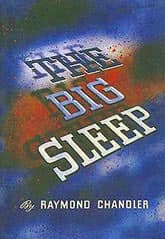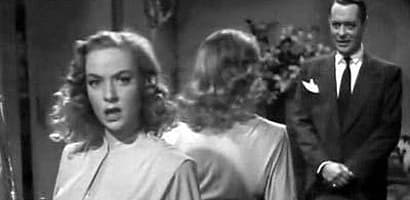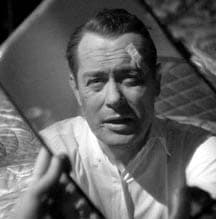The Big Sleep
Critique • Quotes • Philip Marlowe at the movies
 First edition
First editionThe Big Sleep
First publication
1939
Literary form
Novel
Genres
Crime, mystery
Writing language
English
Author's country
United States
Length
Approx. 72,000 words

Self-directed Robert Montgomery uses mirrors in Lady in the Lake to show himself as Marlowe.
Reflections of Marlowe
Lady in the Lake (1947): Film, 105 minutes; director Robert Montgomery; writer Steve Fisher; featuring Montgomery, Audrey Totter, Lloyd Nolan
Many noteworthy actors have portrayed Philip Marlowe over the years in adaptations of Raymond Chandler's works—some true to the original Chandler character and some completely revisionist.
One of the oddest impersonations by a big-name star though is one in which the character disappears from our vision for all but a few seconds here and there.
Hollywood leading man Robert Montgomery directed himself as Marlowe in Lady in the Lake (1947), based on the Chandler novel of almost the same name. But we don't get to see much of his good looks. That's because he adopts an experimental—and ultimately annoying—way of filming.
Except for a brief prologue and epilogue, everything is shown only through Marlowe's eyes. So, in effect, we see the protagonist only when he looks in a mirror.
Sounds interesting. Sounds innovative. But in practice it leads to some quite awkward situations that distance the viewer.
Other actors have to interact with the Marlowe character in an artificial fashion. They have to keep telling us what the guy is doing: "Come in. What a nice blue-and-white checked suit you're wearing. You can sit over there. All right, stand if you want. Yes, that's a painting of my last duchess you're looking at. Don't touch."
Okay, I made that up. But Lady in the Lake does come close to self-parody at times. A kissing scene with Audrey Totter's lips approaching and eventually smothering the camera is reminiscent of a campy 3D horror film of the 1950s.
Totter and (briefly) Montgomery are seen in the optical perspective of Lady in the Lake.
The story? Not bad as a whodunit. Pretty good actually, for maybe a television episode.
But so much time is required for weird camera movements—whenever Marlowe purportedly turns his head, for example—and with other people walking in and out of view that the usual problem of cramming a novel into a shorter medium is exacerbated. We get only the surface action with little complicating nuance.
There are some who considers Montgomery's laudable experiment a neglected masterpiece but, innovations aside, there's little depth here. We barely skim this lake, with or without a lady in it.
— Eric


